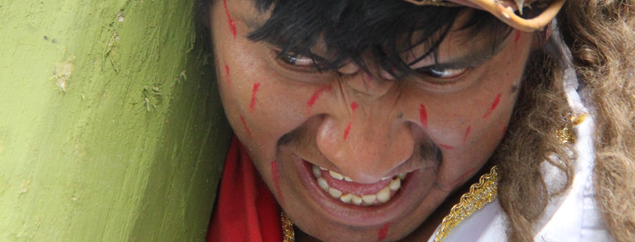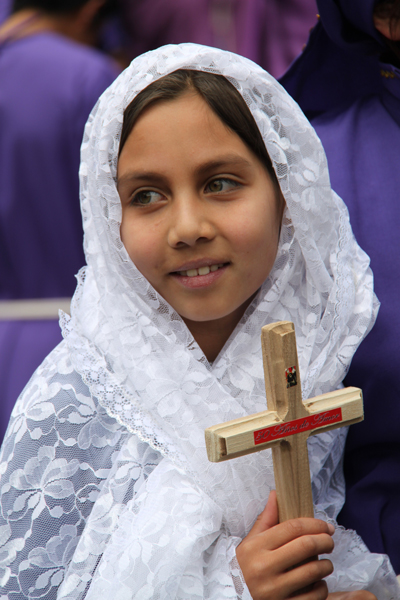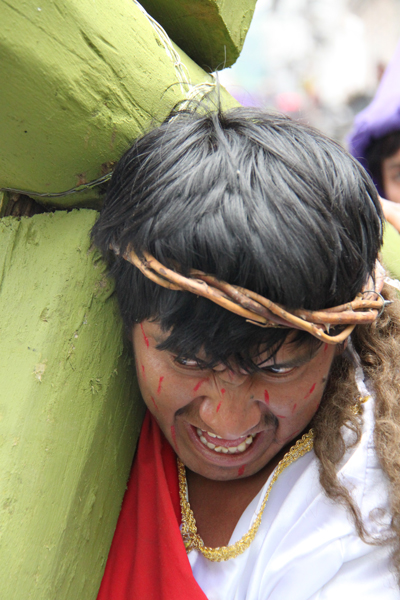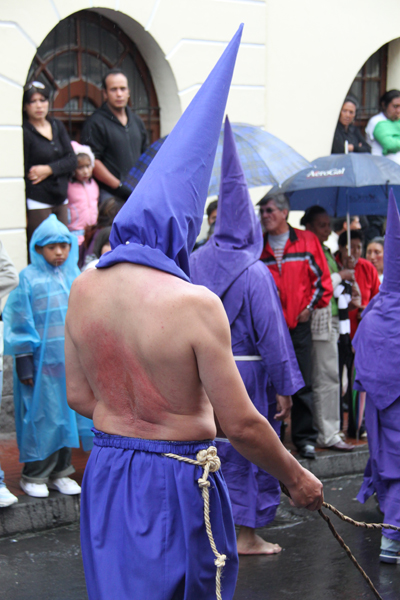
Semana Santa: Celebrating Faith in Quito
02 May, 2011Heavy chains dragged on the ground, whips violently cracking on flesh, musicians playing in honour of God, spectators praying as penitents pass, priests’ voices giving their sermons… The sounds of Semana Santa (“Holy Week”) still echo in the streets of Quito, the capital of Ecuador.
For one week, like every year, the city was the scene of festivities expressing the fervent faith of the Quiteños, its inhabitants. Starting with Palm Sunday, on April 17th, Semana Santa, the most important week of the catholic calendar, ended on Easter Sunday, April 24th.
More than 90% of Ecuadoreans are Catholic, making Semana Santa a major event in Quito. Also called Semana Mayor (“the Great Week”) this week of worship embodies the last days of Jesus Christ, commemorating his suffering, his crucifixion and finally his resurrection. Like any other part of the world, the sacred dates are celebrated with masses and processions. In Quito, all the events preceding the Holy Friday are just a taster. Everybody is waiting for Good Friday and its famous procession Jesus del Gran Poder, “Jesus of Great Power”..

Held in honour of Jesus’ sacrifice, this procession consists of thousands of penitents marching solemnly through the narrow streets of the old centre of Quito, from and to the San Francisco church. Cucuruchos, Veronicas, Jesus holding the burden of the cross, Roman soldiers, representations of Jesus del Gran Poder and Our Lady of Sorrow… Many characters take part in the procession. The most prominent are the Cucuruchos, penitents wearing purple robes with white rope around their waists and cone-shaped hoods (hence the name cucurucho which means cone-shaped), hiding their faces, with two holes for the eyes. Historically, the robe and the hood were worn in Spain by flagellants, by people sentenced to death, or during the Inquisition. As for the Veronicas, they are veiled women dressed in purple. They play the role of Veronica, the woman who wiped the face of Jesus Christ when he was on his way to the Calvary. All these characters can be performed by anyone willing to suffer for their sins.
This year, early in the morning, like any other year, hundreds of participants, from all generations, rushed to San Andres, a Catholic high school, to leave their regular clothes and convert themselves into martyrs. In a surprisingly happy atmosphere, some chained their bare-feet, others installed a heavy wood beam on their shoulders, others covered their faces and bodies with fake blood, and the most fervent ones vigorously rubbed themselves with nettles or attached a bunch around their ankles. “I got used to it, it doesn’t burn anymore”, yelled a little kid to his father.

Fernando, a mechanic from Quito, knew this routine very well. He had taken part for over ten years. This year, he would march with his seven-year-old nephew, Juanito, who was also accustomed to the procession as he had been a penitent for at least three years. According to his uncle, he was well aware of the meaning of the procession and he would pray in the name of the rest of his family in the crowd. For the man, this procession was a way to thank God for having a job and good health. But this year, he especially wanted to pray for the Lord to stop the plague of rain which had provoked many landslides in the city. In contrast, it was the first time Elias, a self-employed Quiteño, would take part in the Good Friday ceremony, as he felt fortunate and thankful. “I don’t know how to pay Him back”, he said. A year ago, on Good Friday, his ten-year-old son fell from the fourth floor and did not seriously hurt himself. “It was a sad and happy day at the same time”, he confessed. “Participating in the procession is little in comparison with what He has done for me. Now I want to go further and be a better person”, he concluded.
While the participants were getting dressed, a priest was calling for prayers through the microphone. Prayers before more prayers. When ready, all the penitents tried to kill some time by joking around, having a chat, or even reading the newspaper. Then, they all stood in a long queue rounding the high school courtyard. Suddenly the harmony was disrupted by shouting from the corner of the yard. An argument, witnessed by a priest, had just erupted. They were fighting over the presence of a group of penitents in favour of bullfights. “Politics is not welcomed here”, shouted one. “We are allowed to pray like anybody else”, another one replied. After a long debate, the aficionados gave up and took out their shirts with the polemical inscription “Jesus del Gran Poder, Patrono de los toreros”, meaning “Jesus del Gran Poder, Patron saint of bullfighters” and everyone forgot about the incident.

At eleven o’clock, the procession was about to start. The participants entered a dark and narrow corridor, passed through the San Francisco patio to end up in the church from where they would start their march. Outside, thousands of spectators were standing, impatient to share this commemoration of Jesus’ passion. Little by little, all the characters initiated their journey to suffer for their sins. Unexpectedly, a few meters away from the entrance of the church, under the weight of a heavy cross, a penitent fell and broke his leg. After a quick panic in the crowd, the celebration was on again.
While sacred music was echoing through the historic centre and penitents were walking silently; one could hear the sound of the chains dragging on the paved streets and the faithful spectators singing their prayers. Some of the marchers were impassively whipping their back with a rope or a bunch of nettles. After hours of self-torture, blood started dropping from their torn flesh. Caring women would then water the wounds to alleviate the pain. At regular time intervals, the procession stopped walking. It was time for the sinners to pray and also the opportunity for those crushed by the weight of their crosses to have a quick rest.

As the hours passed by, the crowd got bigger and bigger, although heavy rain could have ruined the day. They were observing the scenes of suffering astonishingly, pointing out the scars left by the painful instruments. When they could feel that the end of the procession was close, they all scrutinised the horizon to try to perceive the representation of Jesus del Gran Poder, with his heavy cross on his shoulder, the very last element of the procession. After four hours of penance, the procession was over. They had finally expiated their sins. They could relax with their families and friends, dismantle their crosses, take care of their wounds, rest and return to their everyday clothes. Back to normal life.
All photos by Mary-Fleur Tordjmann
Follow Sounds and Colours: Facebook / Twitter / Instagram / Mixcloud / Soundcloud / Bandcamp
Subscribe to the Sounds and Colours Newsletter for regular updates, news and competitions bringing the best of Latin American culture direct to your Inbox.

